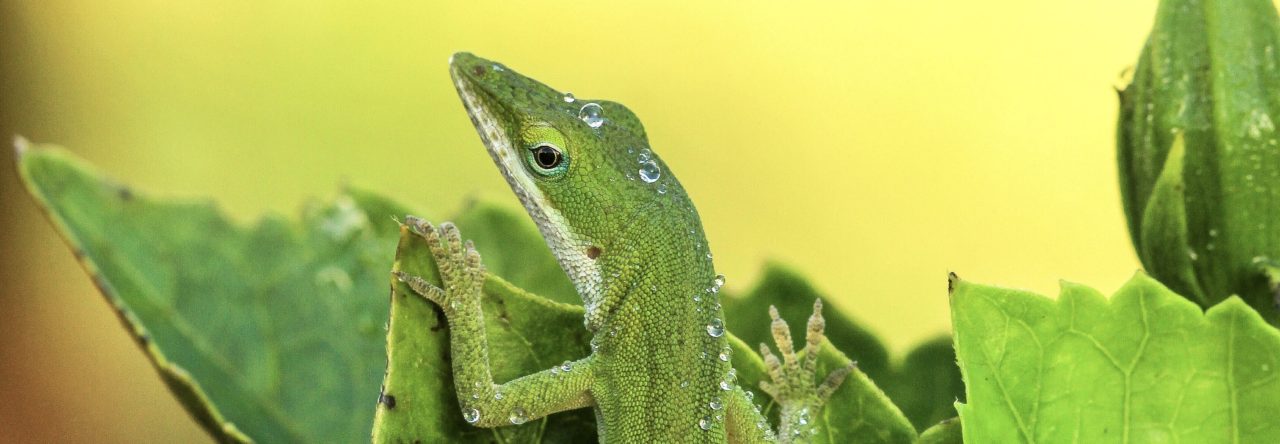I will admit here that I used to be a little jealous of other anole catchers. This twinge of want was not necessarily due to any perceived greater intellectual merit of the research, nor to collecting successes in terms of sheer numbers of lizards. My envy stemmed from the fact that the stories were exotic, involving international travel to islands in the Caribbean both great and small, where supposedly the anoles practically fall out of the trees and astonish you with their diversity and abundance.
I would think to myself how comparatively boring my field work must sound: driving in a blue van with New York plates, weaving across state lines, searching for A. carolinensis, the lone species that lives on the continent — the Drosophila melanogaster of an otherwise thrillingly diverse genus. Can there be a more boring species than a lizard with the word “green” in its common name? Even the folks I meet while traveling in the field hint at mundaneness when I tell them what I am looking for: “Where you really need to look is on my aunt’s patio!” Yes sir, I know they often pop up in the begonias, but will they be there when I need them to be (because they never are)? Plus, I have to be in southern Georgia by tomorrow afternoon so I need anoles from this latitude today!
Anyway…
After three field seasons, I now believe that my Anolis field work is just as cool as what happens on tropical islands or other continents. Here are some reasons why:
1) Geographic range: Even though gas mileage in our Bio Department’s van could be better, when I look at the map of collecting localities I’ve been to, I feel a strong sense of accomplishment. I’ve caught anoles at the southern tip of the Florida penninsula, west of the Mississippi in Arkansas, in the French Quarter of New Orleans (caught a sagrei in the same tree, BTW), and myriad places in between. I’ve caught anoles in the foothills of the Smoky Mountains of Tennessee, at the highest latitude any Anolis occurs in the world. The deciduous woodlands and the fact that it freezes in the winter up there really remind you how carolinensisis is stretching the traditional niche of its tropical evolutionary progenitors.
2) The real America: Not that red state/blue state junk the pundits talk about. I mean the real America, in all its natural beauty. Picture this, being startled by baby alligators squeaking to the water’s safety while I’m searching for anoles next to a lazy tributary in Louisiana, with a swallow-tailed kite soaring overhead. That big 0l’ gator is out there, too, you can see him. Must be a 12-footer. A chill goes down my spine.
A kingsnake slithers out of my path. Did I mention the snakes? The best part of anole-hunting is the snakes. Where else can you get up in the morning, lift up an old door you find on the forest floor and find one Nerodia, one Thamnophis and one Lampropeltis, then look forward to anoles all sunny day, and when the sun is going down you know odds are you’ll run into an Agkistrodon or two, and on the dark drive out that evening, you can search for colubrids on the road? Only in America!
3) The food: I live in New York, where you can get anything, but the cooking in the South is great because its delicious and it’s not some overpriced novelty. Fried chicken: check. Collard greens: check. Have you ever heard of Poke salit? It’s a toxic weed they pick from the roadside and boil about three times to make it palatable, I’m not kidding. With mustard… SO GOOD!
4) The people. That thing they say about Southern hospitality? It’s true. Once people understand the innocuosness of what I’m doing, they are just generally helpful and polite. But you have to be ready to talk to folks. It’s not the city where you can look at the sidewalk and get away with anonymity.
Not too glamorous, perhaps. And sometimes I come out of the field with more chigger bites than anoles. But I don’t need a passport to do this type of field work, and it always provides all the perks of a great expedition.
- Hundreds of Genes Help to Resolve Green Anole Evolutionary History in North America - October 24, 2016
- The Genetics of Anolis Lizard Tail Regeneration: (Re)generating Major Internet Buzz - August 29, 2014
- Green Anoles, Genomic Evolution And Surfing (Wait, What?) - October 3, 2013





Jonathan Losos
I’ve always thought that A. carolinensis is gorgeous–as well as charming–and that if it lived in Costa Rica, it would be heralded the world over as a beautiful, must-see animal.
Marc Tollis
Very charming indeed. Each male I see sincerely believes he can take me on (from a certain distance). You have to admire it!
Wes Chun
Marc, what is your experience with North Carolina green anoles from Carteret Co.? The reason I ask is, out of the more than 600 preserved specimens I have examined from throughout the range, the largest Anolis carolinensis I have ever seen was collected in 1979 from near South River. If you get the chance, you should borrow it from the North Carolina State Museum (NCSM 020326). I wish I had a photo of it to send you. It is absolutely huge (SVL 81mm) and could pass for a different species!
Marc Tollis
That’s interesting, I did observe and collect anoles in Carteret County, NC (two localities, near Morehead City and Bogue), but they were not of extraordinary size. Wow SVL 81mm, that’s wild!